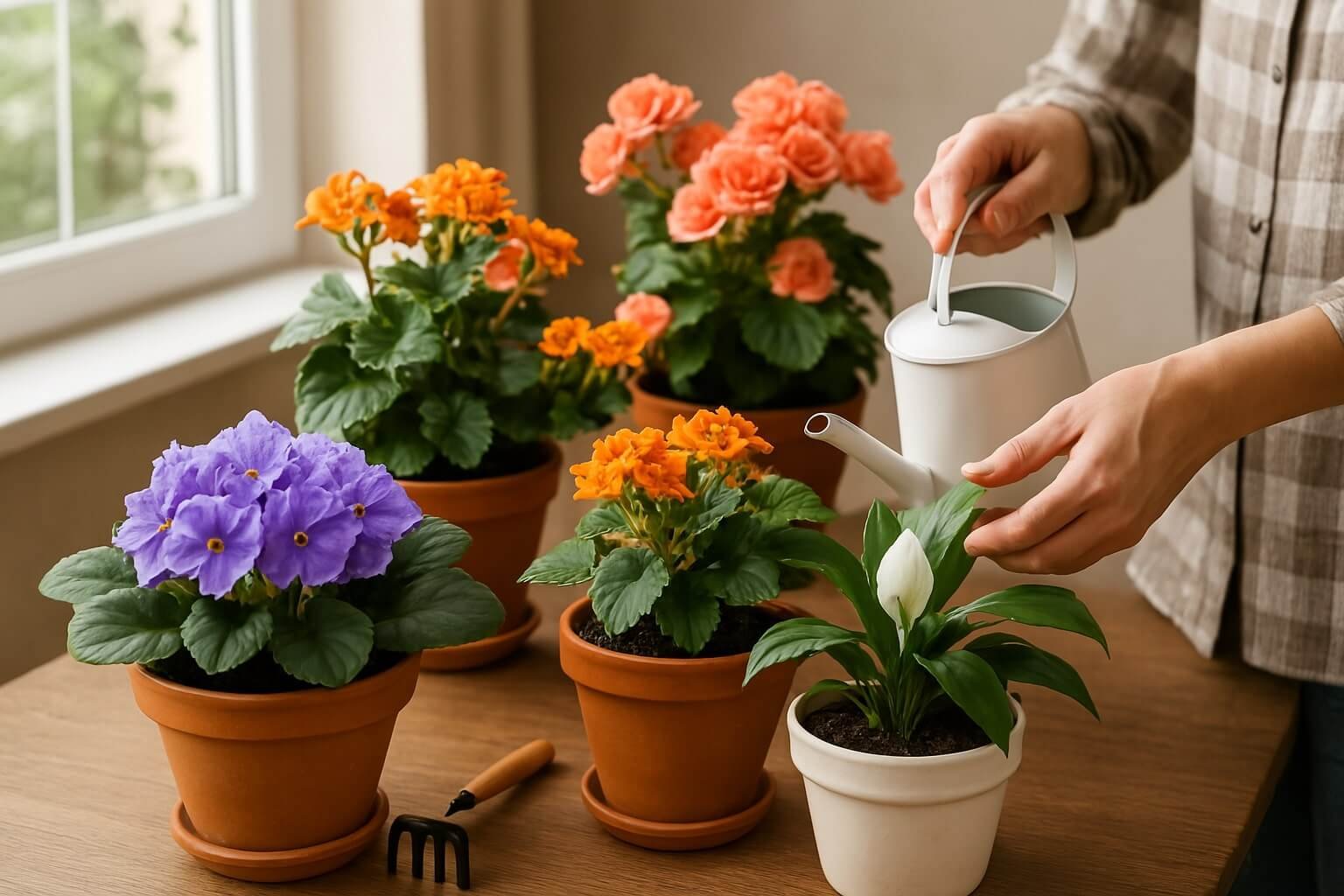A Complete Guide
Indoor flower gardens bring nature’s beauty into your home, transforming ordinary rooms into lush, colorful retreats. Whether you’re a beginner or an experienced plant parent, caring for indoor blooms requires attention, consistency, and a touch of finesse. This guide walks you through the essentials of indoor flower garden care, including lighting, watering, soil selection, pest control, and seasonal strategies.
🪴 Why Choose an Indoor Flower Garden?
Indoor flower gardens offer more than just aesthetic appeal. They:
- Improve air quality by filtering toxins
- Boost your mood and reduce stress
- Serve as a creative outlet
- Elevate interior design with vibrant colors and textures
- Allow year-round gardening regardless of weather
From peace lilies to African violets, indoor flowers are perfect for adding charm and life to your home or workspace.
☀️ 1. Understand Your Light Conditions
Light is the lifeblood of any indoor garden. Here’s how to match flowers with available lighting:
🌞 Bright, Direct Light
- Ideal for: Geraniums, hibiscus, orchids
- Best locations: South or west-facing windows
🌤️ Indirect Light
- Ideal for: Peace lily, anthurium, begonia
- Best locations: East-facing windows with sheer curtains
🌚 Low Light
- Ideal for: Snake plants, ZZ plants (though not flowering types, they complement flower arrangements)
- Supplement with grow lights if natural light is insufficient
Pro Tip: Rotate plants weekly to ensure even light exposure and prevent leaning.
💧 2. Master the Art of Watering
Overwatering is the #1 killer of indoor flowers. Follow these tips to get it right:
- Check soil moisture with your finger or a moisture meter
- Water when the top 1–2 inches of soil feel dry
- Use pots with drainage holes to prevent root rot
- Collect excess water in saucers and discard after a few hours
Some flowers like begonias prefer slightly moist soil, while others like orchids thrive with occasional deep soaking. Observe plant behavior and adjust accordingly.
🌱 3. Choose the Right Soil & Containers
Healthy soil = happy flowers. Pick well-draining potting mixes enriched with organic matter and nutrients. Consider:
- Peat-based mixes for moisture retention
- Perlite or sand to boost drainage
- Compost for added fertility
When selecting containers:
- Use terracotta pots for breathability
- Opt for ceramic or plastic pots for moisture-loving plants
- Ensure every pot has adequate drainage holes
Repot annually to refresh soil and check for root-bound plants.
🐛 4. Keep Pests & Diseases in Check
Indoor gardens aren’t immune to pests. Common invaders include:
- Spider mites
- Aphids
- Fungus gnats
Combat these with:
- Neem oil sprays or insecticidal soap
- Sticky traps for gnats
- Regular leaf wiping with damp cloth
If leaves yellow or drop prematurely, check for signs of disease like powdery mildew or root rot. Quarantine affected plants promptly.
🌿 5. Fertilize Wisely for Vigorous Blooms
Indoor flowers need nutrients to thrive, especially during the growing season (spring to fall). Use:
- Liquid fertilizers every 2–4 weeks
- Slow-release pellets every 2–3 months
- Specialized bloom boosters (high phosphorus content)
Always follow label instructions and avoid overfeeding, which can lead to burnt roots or leggy growth.
🧤 6. Prune and Deadhead Regularly
Pruning encourages new growth and keeps flowers compact and tidy. Tips:
- Use clean, sharp scissors
- Trim leggy stems to promote branching
- Remove yellow or brown leaves
Deadheading—snipping spent blooms—redirects energy toward new flowers and prevents seed production.
🍂 7. Seasonal Care Tips
Each season demands slight tweaks in care:
Spring/Summer
- Increase watering and feeding
- Repot as needed
- Expect vigorous growth
Autumn/Winter
- Reduce watering and pause feeding
- Move plants away from cold drafts
- Use humidifiers if indoor air becomes too dry
Monitor sunlight changes and shift placement if needed.
🌼 Beginner-Friendly Flower Choices
Want easy-to-care-for flowers? Try these:
- African Violets: Compact and colorful
- Peace Lilies: Elegant and low-light tolerant
- Kalanchoe: Bright blooms with minimal fuss
- Begonias: Fast-growing with vibrant foliage
🌺 Styling Tips for Indoor Flower Gardens
Mix and match textures, sizes, and colors for a designer look:
- Combine leafy greens with delicate blooms
- Use hanging baskets or vertical planters to add depth
- Group plants in odd numbers for balanced composition
Rotate flowers based on season for freshness and variety.
❓ Frequently Asked Questions (FAQ)
1. Can indoor flowers survive without sunlight?
Most flowers need light—if natural light is limited, use LED grow lights that mimic sunlight.
2. How often should I water indoor flower plants?
Depends on the species and season, but generally once a week is enough. Let the soil guide you!
3. What is the best potting mix for flowering plants?
A peat-based mix with perlite and compost provides good drainage and nutrients.
4. How do I make my indoor flowers bloom more?
Ensure sufficient light, balanced fertilizing, and regular pruning. Temperature and humidity also play key roles.
5. Do indoor flowers improve air quality?
Yes! Flowers like peace lilies and gerbera daisies can filter indoor pollutants.





